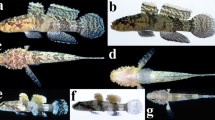Abstract
Secondary sexual characteristics are features that appear at sexual maturity and distinguish the two sexes of a species. They are readily observed and studied in living animals, but the phenomenon is rather more difficult to identify in fossil taxa. Here we report a new sexually dimorphic stem-neopterygian fish, Venusichthys comptus gen. et sp. nov., based on 30 exceptionally well-preserved specimens from the Middle Triassic (Pelsonian, Anisian) Luoping Lagerstätte of eastern Yunnan, China. The discovery represents the oldest known secondary sexual characteristics in Neopterygii. These characteristics, including pointed tubercles on cranial bones, scales and fins, and hook-like contact organ anterior to the anal fin, have three inferred primary functions: maintenance of body contact between the sexes during prespawning behavior or spawning; stimulation of the females during breeding; and defense of nests and territories. Lacking a specialized anal fin in the presumed males, Venusichthys would likely have a different reproductive strategy from peltopleurids and other potentially viviparous stem-neopterygians. Moreover, Venusichthys shows a unique character combination distinguished from any other stem-neopterygian families and consequently represents a new family of this clade. As such, the new finding provides an important addition for understanding the behavior, reproduction, and early diversification of Neopterygii.
摘要
第二性征是动物在性成熟所表现的、可以用来分辨物种性别的特征。第二性征比较容易在现生物种中观察到,但是它们很难在化石中识别。根据采集于云南罗平中三叠世安尼期海相地层的三十块鱼化石,本文报道了基干新鳍鱼的一个新属种:多饰维纳斯鱼(Venusichthys comptus)。维纳斯鱼具有明显的性双型:成年雄鱼具有第二性征,包括雄鱼头部、鳞片和鳍条上的尖突,以及臀鳍前面钩状的接触器。这些第二性征可能用于增进雌、雄鱼体产卵前或产卵中的身体接触,刺激雌鱼排卵,以及保护巢穴和领地。维纳斯鱼不具有肋鳞鱼类或其它卵胎生鱼类那样特化的臀鳍,它的生殖方式可能不是卵胎生的。维纳斯鱼代表了新鳍鱼类第二性征的最早记录,它的发现为了解新鳍鱼类的行为、繁殖方式和早期分异提供了重要信息。




Similar content being viewed by others
References
Darwin C (1871) The descent of man and selection in relation to sex. John Murray, London
Clutton-Brock T (2007) Sexual selection in males and females. Science 318:1882–1885
Knell RJ, Naish D, Tomkins JL et al (2013) Sexual selection in prehistoric animals: detection and implications. Trends Ecol Evol 28:38–47
Nelson JS (2006) Fishes of the world, 4th edn. Wiley, Hoboken
Benton MJ, Zhang QY, Hu SX et al (2013) Exceptional vertebrate biotas from the Triassic of China, and the expansion of marine ecosystems after the Permo-Triassic mass extinction. Earth Sci Rev 125:199–243
Zhang QY, Zhou CY, Lü T et al (2008) A conodont-based Middle Triassic age assignment for the Luoping Biota of Yunnan, China. Sci China, Ser D Earth Sci 52:1673–1678
Hu SX, Zhang QY, Chen ZQ et al (2011) The Luoping biota: exceptional preservation, and new evidence on the Triassic recovery from end-Permian mass extinction. Proc R Soc B 278:2274–2282
Wiley ML, Collette BB (1970) Breeding tubercles and contact organs in fishes: their occurrence, structure, and significance. Bull Am Mus Nat Hist 143:145–216
Lombardo C (1999) Sexual dimorphism in a new species of the actinopterygian Peltopleurus from the Triassic of northern Italy. Palaeontology 42:741–760
Nielsen E (1949) Studies on Triassic fishes from East Greenland. II. Australosomus and Birgeria. Medd Grønl 146:1–309
Bürgin T (1992) Basal ray-finned fishes (Osteichthyes; Actinopterygii) from the Middle Triassic of Monte San Giorgio (Canton Tessin, Switzerland). Schweiz Paläontol Abh 114:1–164
Lin HQ, Sun ZY, Tinori A et al (2011) A new species of Habroichthys Brough, 1939 (Actinopterygii; Peltopleuriformes) from the Pelsonian (Anisian, Middle Triassic) of Yunnan Province, South China. Neues Jahrb Geol Paläontol Abh 262:79–89
Xu GH, Gao KQ, Coates MI (2015) Taxonomic revision of Plesiofuro mingshuica from the Lower Triassic of northern Gansu, China, and the relationships of early neopterygian clades. J Vertebr Paleontol 35:e1001515
Lund R (2000) The new Actinopterygian order Guildayichthyiformes from the Lower Carboniferous of Montana (USA). Geodiversitas 22:171–206
Hurley IA, Mueller RL, Dunn KA et al (2007) A new time-scale for ray-finned fish evolution. Proc R Soc B 274:489–498
Xu GH, Gao KQ, Finarelli JA (2014) A revision of the Middle Triassic scanilepiform fish Fukangichthys longidorsalis from Xinjiang, China, with comments on the phylogeny of the Actinopteri. J Vertebr Paleontol 34:747–759
Hu SX, Zhang QY, Wen W et al (2015) The Luoping Biota: a taphonomic window on Triassic biotic recovery and radiation. Yunnan Science & Technology Press, Kunming
Brough J (1939) The Triassic fishes of Besano, Lombardy. British Museum (Natural History), London
Mutter RJ, Herzog A (2004) A new genus of Triassic actinopterygian with an evaluation of deepened flank scales in fusiform fossil fishes. J Vertebr Paleontol 24:794–801
Xu GH, Zhao LJ, Shen CC (2015) A Middle Triassic thoracopterid from China highlights the evolutionary origin of overwater gliding in early ray-finned fishes. Biol Lett 11:20140960
Kwan L, Cheng YY, Rodd FH et al (2013) Sexual conflict and the function of genitalic claws in guppies (Poecilia reticulata). Biol Lett 9:20130267
Acknowledgments
We thank M.M. Chang for constructive suggestions, H. Furrer and M. Richter for access to comparative fossil material in the Paläontologisches Institut and Museum, Universität Zürich (Zürich), and the Natural History Museum (London), respectively, and J.A. Finarelli for stylistic improvement. The research was supported by the National Natural Science Foundation of China (41272002) and the State Key Laboratory of Palaeobiology and Stratigraphy (Nanjing Institute of Geology and Palaeontology, Chinese Academy of Sciences; 143114).
Author information
Authors and Affiliations
Corresponding author
Ethics declarations
Conflict of interest
The authors declare no conflict of interest on this manuscript.
Electronic supplementary material
Below is the link to the electronic supplementary material.
About this article
Cite this article
Xu, GH., Zhao, LJ. A Middle Triassic stem-neopterygian fish from China shows remarkable secondary sexual characteristics. Sci. Bull. 61, 338–344 (2016). https://doi.org/10.1007/s11434-016-1007-0
Received:
Revised:
Accepted:
Published:
Issue Date:
DOI: https://doi.org/10.1007/s11434-016-1007-0




